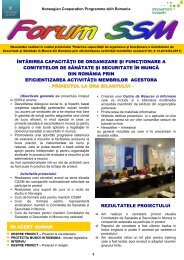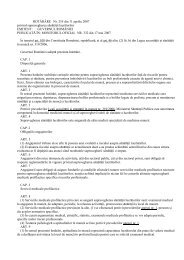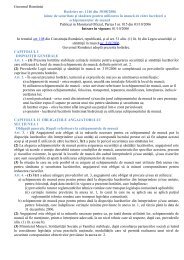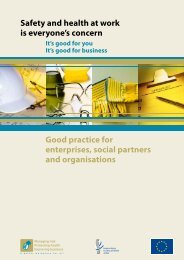Preventing work-related musculoskeletal disorders - European ...
Preventing work-related musculoskeletal disorders - European ...
Preventing work-related musculoskeletal disorders - European ...
You also want an ePaper? Increase the reach of your titles
YUMPU automatically turns print PDFs into web optimized ePapers that Google loves.
<strong>Preventing</strong> <strong>work</strong>-<strong>related</strong> <strong>musculoskeletal</strong> <strong>disorders</strong><br />
pressure, and diseases due to overstraining of the tendon sheath<br />
and the peritendineum. It should be borne in mind, however, that<br />
the Recommendation was not binding.<br />
On this basis, an important document was drawn up by a group of<br />
experts convened by the Commission. It was entitled Information<br />
notice on the diagnosis of occupational diseases and provides<br />
information on the causal relations between diseases and their<br />
occurrence in the <strong>work</strong>place.<br />
The Commission is very concerned to develop its knowledge and<br />
understanding of <strong>musculoskeletal</strong> <strong>disorders</strong> at <strong>work</strong>, and uses<br />
various sources of information to this end, such as the “Working<br />
conditions in the <strong>European</strong> Union” survey published regularly by the<br />
<strong>European</strong> Foundation for the Improvement of Living and Working<br />
Conditions in Dublin, and data collected by the <strong>European</strong><br />
Communities’ Statistical Office.<br />
As part of the Community Programme concerning safety, hygiene<br />
and health at <strong>work</strong> (1996-2000), the Commission made (Action 8)<br />
“new proposals for high-risk activities or for certain categories of<br />
<strong>work</strong>ers”. As a result of its cooperation with the Dublin Foundation<br />
and the Bilbao Agency, and its continuing dialogue with the<br />
Member States, the social partners and scientific communities, the<br />
Commission will be able to identify the areas where <strong>work</strong>ers are not<br />
adequately protected by the existing legislative frame<strong>work</strong>. These<br />
may include new high-risk activities, those <strong>work</strong>ing in specific<br />
sectors of industry with exceptional risks, and categories of <strong>work</strong>ers<br />
excluded from the present legislation. Once these high-risk activities<br />
have been identified, the Commission will consider the most<br />
appropriate ways and means of combating them; this may or may<br />
not involve legislation.<br />
Against this background, the Bilbao Agency conducted a study in<br />
1999, at the request of the <strong>European</strong> Commission, on “<strong>work</strong>-<strong>related</strong><br />
neck and upper limb <strong>musculoskeletal</strong> <strong>disorders</strong>” (see previous<br />
articles). Statistically, such <strong>disorders</strong> constitute most <strong>work</strong>-<strong>related</strong><br />
<strong>musculoskeletal</strong> <strong>disorders</strong> apart from back problems, the prevention<br />
of which is provided for by Directive 90/269/EEC, as mentioned<br />
above. This study presents information and results from research<br />
already conducted in the Member States of the <strong>European</strong> Union,<br />
analyses specific risk factors and provides some very useful<br />
information on the prevention of <strong>work</strong>-<strong>related</strong> <strong>musculoskeletal</strong><br />
<strong>disorders</strong>.<br />
At present, with the assistance of the Advisory Committee on Safety,<br />
Hygiene and Health Protection at Work, the <strong>European</strong> Commission<br />
is examining the options for Community action with a view to the<br />
effective prevention of <strong>work</strong>-<strong>related</strong> <strong>musculoskeletal</strong> <strong>disorders</strong>.<br />
SETTING STANDARDS<br />
Standards could play a key role in preventing<br />
<strong>musculoskeletal</strong> <strong>disorders</strong> in the <strong>work</strong>place,<br />
according to Dr J.A. Ringelberg, convenor of<br />
the CEN*/TC 122 Working Group on<br />
Biomechanics.<br />
She believes that there is a role for standards in<br />
preventing <strong>work</strong>-<strong>related</strong> <strong>musculoskeletal</strong><br />
<strong>disorders</strong>. “There is of course an important role<br />
for standards as a preventive process in relation<br />
to the design of machinery and other products<br />
used in the <strong>work</strong>place. And on the other hand<br />
also for the development and design of the<br />
<strong>work</strong>place itself and the design of <strong>work</strong> tasks.”<br />
The aim of standards in this area is to put<br />
forward a methodology for risk assessment to<br />
prevent MSDs at <strong>work</strong>. As such, standards are<br />
primarily for designers of machinery rather than<br />
for employers. However, once standards for<br />
MSD risk assessment become available, they<br />
could be used in court in cases of MSD injury.<br />
There is a great need for agreed standards. “A<br />
lot of people are just at the moment telling us<br />
that they need these standards,” she says.<br />
However, <strong>musculoskeletal</strong> <strong>disorders</strong> and<br />
ergonomics are not as highly developed as<br />
other fields in occupational safety and health,<br />
such as toxicology. Indeed we’re still at the<br />
starting point for the prevention of<br />
<strong>musculoskeletal</strong> disorder, she says.<br />
Nevertheless, <strong>European</strong> <strong>musculoskeletal</strong><br />
standards are currently being developed, the<br />
key aspects of which, together with their state<br />
of development, are summarised below.<br />
prEN 1005-1 deals with the safety of machinery<br />
and human physical performance and puts<br />
forward terms and definitions on matters such<br />
as manual handling and posture, while<br />
presenting the terminology used in the draft<br />
standard. Work is ongoing on it and it has yet to<br />
be adopted.<br />
prEN 1005-2 puts forward a risk assessment<br />
methodology for manual handling of<br />
machinery and component parts of machinery.<br />
Not yet adopted, improvements and additions<br />
are currently being added to the draft standard.<br />
Voting on part 2 is expected to take place<br />
before the end of 2000.<br />
prEN 1005-3 puts forward recommended force<br />
limits for operating machinery. It would require<br />
designers to take into account matters such as<br />
the force required by operators to push a pedal.<br />
The pre-standard is on track for acceptance as a<br />
harmonised standard.<br />
prEN 1005-4 concerns the evaluation of<br />
<strong>work</strong>ing postures in relation to machinery. It<br />
advises designers on postures that <strong>work</strong>ers can<br />
healthily adopt while operating machinery,<br />
advising mainly about the trunk and upper<br />
limbs. For instance, people should not have to<br />
bend forward for a long time or have to stretch<br />
to lift or push a button or have to assume an<br />
awkward standing posture. A new version of<br />
the pre-standard is expected before the end of<br />
2000.<br />
prEN 1005-5 puts forward a risk assessment<br />
procedure for the design of machinery requiring<br />
repetitive handling at high frequency. It deals<br />
with repetitive handling of small items weighing<br />
less than 3 kilograms. A first draft of the<br />
<strong>work</strong>ing group’s document was in preparation<br />
and was due to be sent to the technical<br />
committee in October 2000.<br />
* CEN is the <strong>European</strong> Committee for<br />
Standardisation.<br />
<strong>European</strong> Agency for Safety and Health at Work<br />
15








